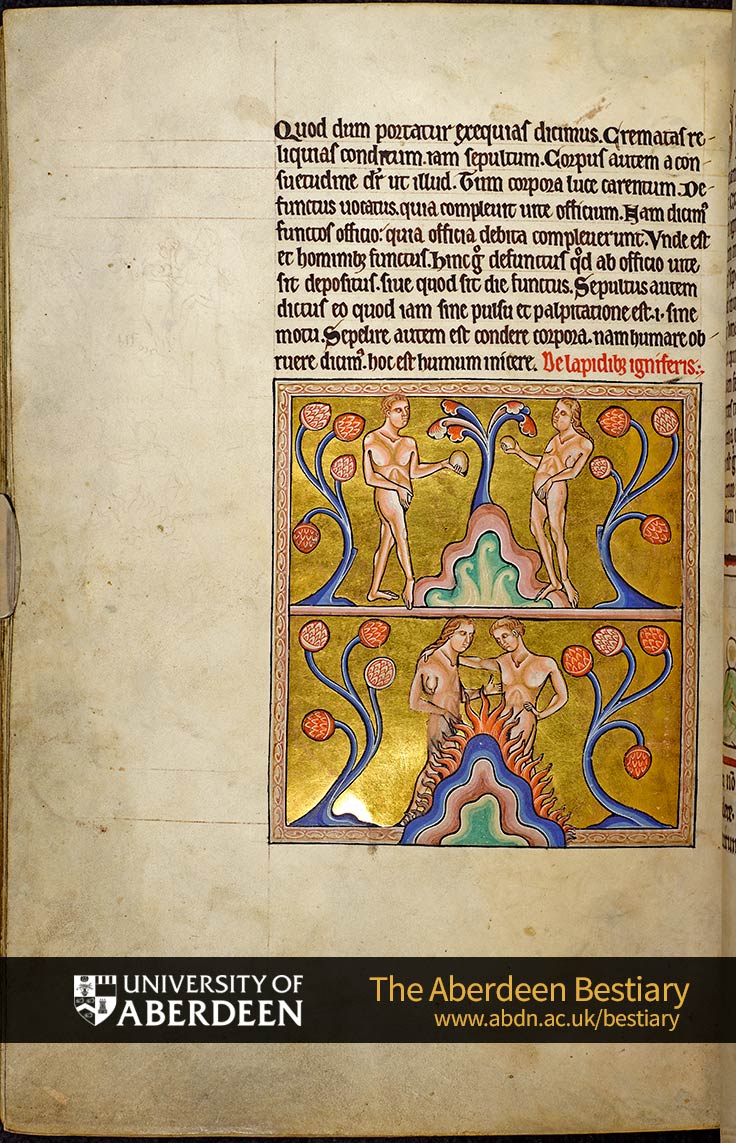- Commentary
-
Commentary
Text
Isidore on the etymology of death. Physiologus on fire-bearing stones.
Illustration
The tale is divided into two scenes. A naked man and woman stand apart above a fire, offering each other fire stones. In the lower image, they embrace.
Comment
A literal illustration of the text only requires a picture of stones, as shown in London, B.L.Harley MS 3244, f. 60, but the arrangement of the figures and tree is intended to suggest the Fall in the Garden of Eden.Fire-bearing stones are male and female. When they are apart the fire does not ignite, when close together, the mountain burns. The warning is for men to stay clear of women and avoid kindling lust. Beside the painting are sketches which are a combination of the Ashmole and Aberdeen illuminations. Ashmole Bestiary, f.103v. Their comparisons are analysed here. There are colour indications: aerie or harie (blue) at the base of the upper marginal sketch (Clark 1992,225, reads this as mine for minium, red); in the upper sketch bisors, (grey). f.93v is glued to f.93r.
Folio Attributes
- Transcription and Translation
-
Transcription
Quod dum portatur exequias dicimus. Crematas re\liquias conditum iam sepultum. Corpus autem a con\suetudine dicitur ut illud: Tum corpora luce carentum. De\functus vocatus, quia officia complevit vite officium. Nam dicimus\ functos officio, quia officia debita compleverunt. Unde est\ et hominibus [PL, honoribus] functus. Hinc ergo defunctus quod ab officio vite\ sit depositus, sive quod sit die functus. Sepultus autem\ dictus eo quod iam sine pulsu et palpitatione est, id est sine\ motu. Sepelire autem est condere corpora, nam humare ob\ruere dicimus, hoc est humum inicere. \ De lapidibus igniferisTranslation
When the body is carried, we speak of a funeral procession, exequie. When the remains are burned, we call them reliquie. When the body is interred, we say it is now buried, sepultus. The common word is corpus as in the quotation: 'The bodies of those lacking light' (Vergil, Georgics, 4, 255). We call someone dead, 'defunct', defunctus, because he has completed the office of life. For we talk of someone having discharged an office, functus officio, because they have completed the duties required of them. In the same way we also talk of someone discharging public business. For this reason, therefore, we use the word defunctus, because the deceased has been set aside from the office of life, or because he has completed the duties of life's day. The word for 'buried', sepultus, is so called because the body is that point without a pulse, sine pulsu, or palpitation, that is, motionless. The word sepelire means to bury bodies; we use the words humare and obruere, that is, to cast earth on the body. Of fire-bearing stones

